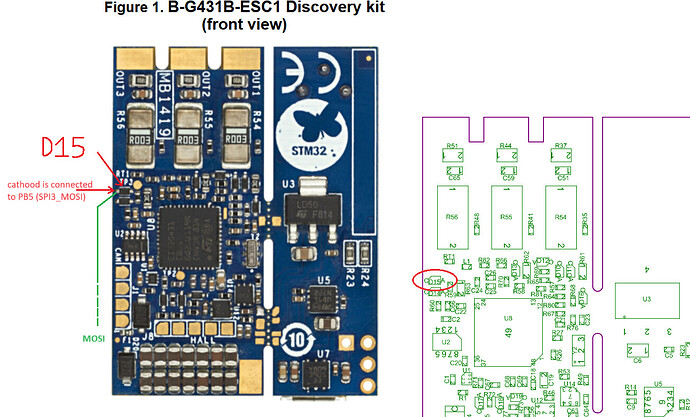SPI modification more detailed steps (hopefully):
Tested the board with small drone motors, usually they have phase resistance of 0.1ohm, close loop control didn’t work using I2C AS5600 sensor. So i tried to modify the board for SPI to use AS5048A, i followed steps above from @Magneon and @Grizzly, and i succeeded, closed-loop control got to work perfectly. hardware modification part is not so hard, but you need some good soldering skills, the only hard part is connecting a wire to an SMD diode, but only if you want full SPI (read and write) you can make sure first that your sensor support read-only SPI with Arduino. those are the steps in more detail:
Theory:
from G431 mcu datasheet, we can see that PB4, PB3 which are used for Serial (USART2), and are easily accessible from TX, RX board pads, can be used also as SPI3_MISO, SPI3_SCK. while PA_15 which is used as PWM input, and easily accessible from PWM board pad, could be used as SPI3_NSS, also, PB5 which is used for back emf reading purposes (which is usually not necessary for SimpleFoc usage), could be used as SPI3_MOSI. but the easiest way to access it is by soldering a wire to D15 cathode.
the board allows to disconnect PB4, PB3 from serial and free them by removing the two zero ohm resistors R23, R24. To enable Serial again, we will use USART1 instead, as its pins PB6, PB7 are easily accessible from sensor board pads H1, H2. so we want to connect H1, H2 to R23, R24 pads and redefine pins configuration in board software files
LEVEL 1: read-only SPI, Serial disabled:
Hardware:
remove the zero ohm resistors R23, R24
use board pads UART TX, UART RX, PWM as SCK, MISO, NSS respectively
set MOSI pin from sensor to VCC
note that output from board pads (TX, RX, PWM) are 3.3v level
Software:
this step is missed in @Grizzly explanation above, didn’t work without it for me.
In ……\variants\STM32G4xx\G431C(6-8-B)U_G441CBU\PeripheralPins_B_G431B_ESC1.c, uncomment and edit as the following:
//*** SPI ***
#ifdef HAL_SPI_MODULE_ENABLED
WEAK const PinMap PinMap_SPI_MOSI[] = {
// {PA_7, SPI1, STM_PIN_DATA(STM_MODE_AF_PP, GPIO_PULLUP, GPIO_AF5_SPI1)},
// {PA_11, SPI2, STM_PIN_DATA(STM_MODE_AF_PP, GPIO_PULLUP, GPIO_AF5_SPI2)},
// {PB_5, SPI1, STM_PIN_DATA(STM_MODE_AF_PP, GPIO_PULLUP, GPIO_AF5_SPI1)},
// {PB_5_ALT1, SPI3, STM_PIN_DATA(STM_MODE_AF_PP, GPIO_PULLUP, GPIO_AF6_SPI3)},
{PB_5, SPI3, STM_PIN_DATA(STM_MODE_AF_PP, GPIO_PULLUP, GPIO_AF6_SPI3)},
// {PB_15, SPI2, STM_PIN_DATA(STM_MODE_AF_PP, GPIO_PULLUP, GPIO_AF5_SPI2)},
{NC, NP, 0}
};
#endif
#ifdef HAL_SPI_MODULE_ENABLED
WEAK const PinMap PinMap_SPI_MISO[] = {
// {PA_6, SPI1, STM_PIN_DATA(STM_MODE_AF_PP, GPIO_PULLUP, GPIO_AF5_SPI1)},
// {PA_10, SPI2, STM_PIN_DATA(STM_MODE_AF_PP, GPIO_PULLUP, GPIO_AF5_SPI2)},
// {PB_4, SPI1, STM_PIN_DATA(STM_MODE_AF_PP, GPIO_PULLUP, GPIO_AF5_SPI1)},
// {PB_4_ALT1, SPI3, STM_PIN_DATA(STM_MODE_AF_PP, GPIO_PULLUP, GPIO_AF6_SPI3)},
{PB_4, SPI3, STM_PIN_DATA(STM_MODE_AF_PP, GPIO_PULLUP, GPIO_AF6_SPI3)},
// {PB_14, SPI2, STM_PIN_DATA(STM_MODE_AF_PP, GPIO_PULLUP, GPIO_AF5_SPI2)},
// {PC_11, SPI3, STM_PIN_DATA(STM_MODE_AF_PP, GPIO_PULLUP, GPIO_AF6_SPI3)},
{NC, NP, 0}
};
#endif
#ifdef HAL_SPI_MODULE_ENABLED
WEAK const PinMap PinMap_SPI_SCLK[] = {
// {PA_5, SPI1, STM_PIN_DATA(STM_MODE_AF_PP, GPIO_PULLUP, GPIO_AF5_SPI1)},
// {PB_3, SPI1, STM_PIN_DATA(STM_MODE_AF_PP, GPIO_PULLUP, GPIO_AF5_SPI1)},
// {PB_3_ALT1, SPI3, STM_PIN_DATA(STM_MODE_AF_PP, GPIO_PULLUP, GPIO_AF6_SPI3)},
{PB_3, SPI3, STM_PIN_DATA(STM_MODE_AF_PP, GPIO_PULLUP, GPIO_AF6_SPI3)},
// {PB_13, SPI2, STM_PIN_DATA(STM_MODE_AF_PP, GPIO_PULLUP, GPIO_AF5_SPI2)},
// {PC_10, SPI3, STM_PIN_DATA(STM_MODE_AF_PP, GPIO_PULLUP, GPIO_AF6_SPI3)},
// {PF_1, SPI2, STM_PIN_DATA(STM_MODE_AF_PP, GPIO_PULLUP, GPIO_AF5_SPI2)},
{NC, NP, 0}
};
#endif
#ifdef HAL_SPI_MODULE_ENABLED
WEAK const PinMap PinMap_SPI_SSEL[] = {
// {PA_4, SPI1, STM_PIN_DATA(STM_MODE_AF_PP, GPIO_PULLUP, GPIO_AF5_SPI1)},
// {PA_4_ALT1, SPI3, STM_PIN_DATA(STM_MODE_AF_PP, GPIO_PULLUP, GPIO_AF6_SPI3)},
// {PA_15, SPI1, STM_PIN_DATA(STM_MODE_AF_PP, GPIO_PULLUP, GPIO_AF5_SPI1)},
// {PA_15_ALT1,SPI3, STM_PIN_DATA(STM_MODE_AF_PP, GPIO_PULLUP, GPIO_AF6_SPI3)},
{PA_15, SPI3, STM_PIN_DATA(STM_MODE_AF_PP, GPIO_PULLUP, GPIO_AF6_SPI3)},
// {PB_12, SPI2, STM_PIN_DATA(STM_MODE_AF_PP, GPIO_PULLUP, GPIO_AF5_SPI2)},
// {PF_0, SPI2, STM_PIN_DATA(STM_MODE_AF_PP, GPIO_PULLUP, GPIO_AF5_SPI2)},
{NC, NP, 0}
};
#endif
Notes:
MOSI needs to be set in PinMap to something for SPI to work. At least for me, it didn’t work without it.
when initing sensor, set the SPIClass parameter to SPI3, using:
SPIClass SPI_3(PB5, PB4, PB3); // MOSI, MISO, CLK
sensor.init(&SPI_3);
you are asked to set CSN when creating the sensor object, like:
MagneticSensorAS5048A sensor = MagneticSensorAS5048A(PA15);
try SimpleFOCDrivers sensor implementation (like MagneticSensorAS5048A) if SimpleFOC one didn’t work (you read only zeros)
tip: use segger rtt for debugging and monitoring in place of the disabled Serial, check:
https://community.simplefoc.com/t/use-of-segger-rtt-for-monitoring/3192
LEVEL 2: get Serial working, but can’t use H1, H2, H3 for sensor (which are used for ABI, I2C, hall sensors):
Hardware:
connect R23, R24 pads (top ones on the image, or ones away from usb) to H2, H1, respectively
Soldering tips:
you better start by hot glueing the wire and fixing it close to the pad, and then solder them
use silver plated wires
Software:
In file …..\variants\STM32G4xx\G431C(6-8-B)U_G441CBU\variant_B_G431B_ESC1.h, find SERIAL_UART_INSTANCE, and change as following:
#define SERIAL_UART_INSTANCE 1 //Connected to ST-Link
// Default pin used for 'Serial' instance (ex: ST-Link)
// Mandatory for Firmata
#ifndef PIN_SERIAL_RX
#define PIN_SERIAL_RX PB7 // PB4
#endif
#ifndef PIN_SERIAL_TX
#define PIN_SERIAL_TX PB6 // PB3
#endif
In ……\variants\STM32G4xx\G431C(6-8-B)U_G441CBU\PeripheralPins_B_G431B_ESC1.c Add our UART pins UART PinMap:
#ifdef HAL_UART_MODULE_ENABLED
WEAK const PinMap PinMap_UART_TX[] = {
// {PA_2, LPUART1, STM_PIN_DATA(STM_MODE_AF_PP, GPIO_PULLUP, GPIO_AF12_LPUART1)},
// {PA_2_ALT1, USART2, STM_PIN_DATA(STM_MODE_AF_PP, GPIO_PULLUP, GPIO_AF7_USART2)},
// {PA_9, USART1, STM_PIN_DATA(STM_MODE_AF_PP, GPIO_PULLUP, GPIO_AF7_USART1)},
// {PA_14, USART2, STM_PIN_DATA(STM_MODE_AF_PP, GPIO_PULLUP, GPIO_AF7_USART2)},
{PB_3, USART2, STM_PIN_DATA(STM_MODE_AF_PP, GPIO_PULLUP, GPIO_AF7_USART2)},
{PB_6, USART1, STM_PIN_DATA(STM_MODE_AF_PP, GPIO_PULLUP, GPIO_AF7_USART1)},
// {PB_9, USART3, STM_PIN_DATA(STM_MODE_AF_PP, GPIO_PULLUP, GPIO_AF7_USART3)},
// {PB_10, USART3, STM_PIN_DATA(STM_MODE_AF_PP, GPIO_PULLUP, GPIO_AF7_USART3)},
// {PB_11, LPUART1, STM_PIN_DATA(STM_MODE_AF_PP, GPIO_PULLUP, GPIO_AF8_LPUART1)},
// {PC_4, USART1, STM_PIN_DATA(STM_MODE_AF_PP, GPIO_PULLUP, GPIO_AF7_USART1)},
// {PC_10, USART3, STM_PIN_DATA(STM_MODE_AF_PP, GPIO_PULLUP, GPIO_AF7_USART3)},
// {NC, NP, 0}
};
#ifdef HAL_UART_MODULE_ENABLED
WEAK const PinMap PinMap_UART_RX[] = {
// {PA_3, LPUART1, STM_PIN_DATA(STM_MODE_AF_PP, GPIO_PULLUP, GPIO_AF12_LPUART1)},
// {PA_3_ALT1, USART2, STM_PIN_DATA(STM_MODE_AF_PP, GPIO_PULLUP, GPIO_AF7_USART2)},
// {PA_10, USART1, STM_PIN_DATA(STM_MODE_AF_PP, GPIO_PULLUP, GPIO_AF7_USART1)},
// {PA_15, USART2, STM_PIN_DATA(STM_MODE_AF_PP, GPIO_PULLUP, GPIO_AF7_USART2)},
{PB_4, USART2, STM_PIN_DATA(STM_MODE_AF_PP, GPIO_PULLUP, GPIO_AF7_USART2)},
{PB_7, USART1, STM_PIN_DATA(STM_MODE_AF_PP, GPIO_PULLUP, GPIO_AF7_USART1)},
// {PB_8, USART3, STM_PIN_DATA(STM_MODE_AF_PP, GPIO_PULLUP, GPIO_AF7_USART3)},
// {PB_10, LPUART1, STM_PIN_DATA(STM_MODE_AF_PP, GPIO_PULLUP, GPIO_AF8_LPUART1)},
// {PB_11, USART3, STM_PIN_DATA(STM_MODE_AF_PP, GPIO_PULLUP, GPIO_AF7_USART3)},
// {PC_11, USART3, STM_PIN_DATA(STM_MODE_AF_PP, GPIO_PULLUP, GPIO_AF7_USART3)},
{NC, NP, 0}
};
#endif
LEVEL 3: get full SPI
Hardware:
solder a wire to D15 cathode as in the image
Software:
follow @Grizzly explanation: B-G431B-ESC1: Beginner guide + I2C guide - #90 by Grizzly
sorry, I prepared more demonstrating images but can’t post them as the forum doesn’t allow new users to post more than one media file
